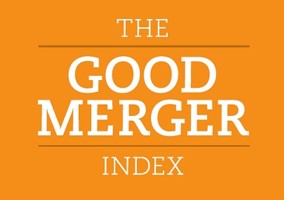The debate about whether there should be more collaboration, including merger, in the voluntary sector has, if not raged, then certainly bubbled for many years. Does the unprecedented challenge thrown up by Covid-19 and the need for financial restructuring and rationalisation make the case for merger even more compelling?
Lawrie Simanowitz, partner at Bates Wells, has advised on several dozen mergers over the years, and his firm has recently launched a free crisis-decision tool to help guide charities through next steps on insolvency, merger, collaboration, cost cutting and raising finance. He says he is struck by what is different about charity mergers compared to those in the private sector. “The basic principles are the same as in the commercial world – two or more organisations coming together. But you have extra layers of charity law, such as where assets are ringfenced and need to keep their purpose, and the recipient structure has to honour that.
“And there is a regulatory concern. Actually, the Charity Commission often has nothing to say about specific mergers, despite people’s worries, but there is still a need to comply with its requirements.”
He continues: “The biggest difference is cultural. I am not saying there is a single culture, but there can be a desire to do things in a lighter touch way. The sector is more friendly, and motivated by a desire to achieve purpose. It is a generalisation, but charities tend to be more collaborative by nature. That’s great, but it can lead to a gung-ho attitude, and not considering the risks, which can be challenging for advisers.
“The backdrop to this is that there are over 180,000 registered charities. Surely that is inefficient. Encouragement from the Charity Commission to merge has not really had a noticeable effect.”
He considers full merger, which is the focus of this discussion, to be where charity A moves its assets and liabilities into charity B, with A then wound up. If the charities can’t decide which should move, they might set up charity C, into which the assets of both A and B move.
Debbie Bankole-Williams, group director, finance & ICT at Choice Support, has been through several mergers, most recently when Choice Support joined with MCCH in January 2019. She challenges one of Simanowitz’s points. “It is not my experience, certainly in the Choice Support merger, that charities take a lighter touch approach. Choice Support and MCCH were similar size businesses, so it was a merger of equals. We applied project management principles in execution, assessed risk, and followed pure business rules.”
There can be pitfalls to creating a new vehicle, says Jeff Scales, head of services, North and Central at Locality. This charity has a role supporting community organisations with merger, and itself came out of a merger between Development Trusts Association and bassac several years ago. “The reality is that if you set up something new you can lose organisational track records,” he says.
He adds that often what is called merger is ultimately where one organisation is shutting down. “The natural one to do so usually, although it is awful to say it, is the one perceived as weaker and smaller, with less complex contractual agreements. Therefore, that organisation can feel that something big and hungry is coming along and taking them on.
“The process needs to recognise this tension, not just in terms of legal and financial arrangements but the butterflies that you create in people’s stomachs. What does that mean for the post-merger entity? As a journey you need to tread incredibly carefully to avoid the feeling of takeover.”
Jonathan Flory, director at Social Finance, trained in M&A as an investment banker around 25 years ago, and he considers that one of the differences between a merger and a sale is that merger is the start of a new relationship, and you are trying to find two parties to come together to make it a good one. “Whatever the driver of the merger, it is about finding a set of relationships that are sustainable in the future. You can get excited about mechanics, but it is important to separate that from the fundamentals of what the new relationship is about.”
Katie Boswell is associate director, strategy and leadership at NPC, which works with charities at all stages of the collaboration spectrum. She is interested in the strategic potential of mergers and has undertaken research on the topic. She highlights that for smaller local charities, full-scale mergers might not be appropriate. “We highlight back office sharing models to help infrastructural efficiency, and something we call white-labelling, which enables local groups to run some operations under a single brand without full merger.”
Time to merge
Some of the consideration around merger requires the luxury of time, points out Leah Swain, chief executive, Community First Yorkshire. Her charity formed following a merger over three years ago, and one of its roles is to support 5,000 voluntary and community organisations in North Yorkshire, where closures and potential mergers are starting to come through. “The collaboration spectrum is one thing, but we are advising charities with limited ability to meet running costs, and whose reserves have been eaten by the Covid crisis. They are in an incredibly difficult position. We stress that if they have the slightest inkling of being in trouble, they should talk to us now so they can keep their options as wide as possible, for as long as possible. But some are looking at closure within weeks rather than months.
“So the merger advice scene has changed. In North Yorkshire 40% of the charities we speak to are saying they will be at risk of closure by the end of October, although some of this might end up being less about closure and more about hollowing out.”
Ben Cairns is director of the Institute for Voluntary Action Research and has been actively involved in researching mergers for 20 years. He was previously a director at the Terence Higgins Trust, which was involved in a number of mergers at the end of the 1990s. “I hope we don’t spend too much time on the 180,000 charities argument,” he says. “If we go down that line then I am reminded of all the organisations I have worked with that initiated merger talks but didn’t merge. When it came to it, they were actually very different beasts which would have destroyed each other.”
He suggests that the best time to merge is when you least need to do it and it is out of strategic choice. However, he agrees that this may not be the case for many at the moment. “Right now, it may be that the merger proposition for many charities is the retention of something versus the gradual disappearance of everything. That can be a difficult vision to organise around, but it may be what we are up against now. If that is the case then we might fruitfully discuss what support cash-and-time-poor organisations will need if they are struggling to think expansively, to achieve the positives of collaboration.”
Scales argues that planned closure is better than bankrupt closure. “In some cases, is that better than merger? You need to look at what is best for beneficiaries. Ultimately, what is the best thing to do in terms of your charitable objectives, rather than organisational survival?”
Bankole-Williams agrees that it is preferable to start merger discussions outside of a crisis situation. “Otherwise a charity can be at the mercy of the rescuing organisation, the white knight,” she says. “And for the rescuer it is not simply about the heart but using their head and determining what value they get from the rescued one. There is pressure on the sector in terms of the financials getting more difficult, which could make mergers less attractive when organisations are struggling.”
She considers that trust is vital in successful mergers, and that it is something that needs to be built. “In our recent merger of equals, we formed a joint executive group. Once you can sort out people issues, whether trustees or the executive, and people know what their position is going to be, conversations and collaboration can begin.”
Simanowitz reflects that one reason for the success of the Locality merger was that DTA and bassac had already spent a long time co-located, sharing resources. “I appreciate this is the ideal and the needs of the current situation won’t necessarily allow that, but it shows what is possible.”
Acknowledging that there can be a lot of emotional attachment to brand, he says that merger doesn’t necessarily mean the disappearance of one or other brand.
Bankole-Williams recalls how they ended up retaining the name Choice Support. “We formed a holding company and the intention was to transfer assets from both charities as subsidiaries. Within a year, with trust building, we had decided on a board with five trustees from each charity and three executives from each. We sat in a room to try and come up with a new name. All those we liked were already taken. So we went back to our values, mission and core purpose, and jointly came to the view that Choice Support was the best name to describe what we are about.”
For Cairns it is important to assess what is most valuable about assets in relation to objects and beneficiaries. “What have we got that is so valuable that if it was lost would have a detrimental effect on beneficiaries? And what is the best vehicle for delivering that benefit? It is hard to achieve fit and trust overnight. It is possible to pull people together in a hurry, but difficult to build emotional capital between organisations and leaders. Merger is therefore a more viable option if people already know each other, as blind dating is likely to be problematic and may not deliver on meeting public benefit.”
Flory also muses on value to stakeholders. “There is an inevitable focus on, for example, six months’ cash flow in any discussion, which disturbs what should be a more rational debate. There are different funding models to consider. Grants, where those who receive them, value them, and contracting, where you have to prove value in a competitive way.”
Scales says that Covid has led to massive changes to previous assumptions. “The property assets of an organisation might seem attractive, but we are seeing a big issue around the real value of those assets, not only as a base but in terms of income generation potential. And that element of uncertainty is not just on the property side. Grant funding has moved to emergency funding, so if you are not in an emergency situation, that tap is turned off. The same with local government funding.
“Large charities may be attracted to acquiring assets of smaller ones, but will now question what value there is, and they require a greater level of future proofing. Therefore acquiring assets as solutions to difficulties may end up sinking them.”
Positive opportunity
While acknowledging the bleak picture across the sector, Boswell offers a counterpoint of hope and a call to action. “There have been positive signs over the last six months, with new forms of collaboration focused on people and communities. There are examples of those previously in competition working together in terms of service delivery, so hopefully that energy and momentum can be built on to consider mergers.”
She also calls on funders and philanthropists to provide better support. “While a few do, notably Esmée Fairbairn with its merger feasibility fund, most don’t see it as a priority. Indeed, in some instances, where they have provided two different grants to two organisations, post-merger they rationalise the grant so the merged entity gets less.”
Swain says that she has started to see local authorities take a proactive stance on which charities they value and want to survive. “They are being braver and having conversations around new ways of working together, collaboration and new partnerships. It is an interesting dynamic as they are often a big stakeholder. Traditionally they have taken a neutral stance, but now there is a sense that if they want those groups that make a difference to residents to survive then they have to act.”
In Bankole-Williams’ experience, local authorities are looking at the survival of larger charities because they themselves are in financial crisis. “Local authorities do have an expectation that charities can deliver services on their behalf at a lower level of cost. Therefore, I am sceptical about their motivation to help charities to survive and think it may be more for their benefit than that of the charities.”
Boswell concludes by emphasising this is a time of huge disruption. “The needs of communities have changed, so we must consider how charities can best meet these needs – and that might mean mergers.”
With thanks to Bates Wells for its support with this feature
Related articles












